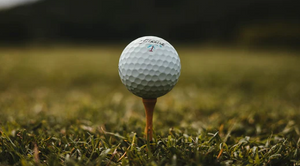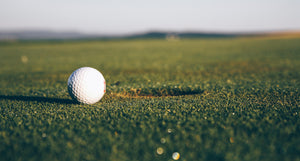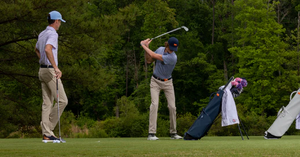What Should Be In A Golf Bag? Beginners' Clubs & Essentials
If you are new to the world of golf, you will have already encountered the sheer number of products available in online golf retailers and your club shop.
As a newbie to the game, it can simply be overwhelming, and you may be unclear on what is essential and what is superfluous.
This guide narrows down what a beginner really should include in their golf bag, and that includes the golf bag – don’t worry, we’ll take a quick look at those too!
As your knowledge of the game increases, it is easier to make the right decisions about clubs and equipment. This guide will help you avoid expensive mistakes and put together the kit you need in your golf bag.
Golf Clubs
US Golf Association (USGA) rules state that each player can carry a maximum of 14 clubs regardless of play level. However, beginners won’t usually need to take the complete set.
Carrying lots of non-essential clubs will just make selection more difficult before you take your shot, and it will undoubtedly increase the weight of your golf bag.
When putting together your own golf set, a putter and a driver are essential. The driver allows you to get distance with a single swing, and the putter is used for precision work on the greens.
For the rest of the clubs, you will need a selection of irons, fairway woods, and hybrids. These clubs are ranked with numbers that guide how much height and distance that particular club should deliver.
A beginner should carry between 4-5 irons. Choose irons with a number ranking five or higher as these are easier to use. Irons with wider soles are simpler to master than narrow-bladed irons.
Include a sand iron if you play courses with lots of bunkers and a pitching wedge for precision shots just off the green. Add a couple of fairway woods and hybrids for distance shots.
The loft is another factor to consider when choosing golf clubs. The higher the loft a club has, the easier it is to get the ball into the air and control it when it is airborne.
Choose fairway woods with a loft of 17 degrees as a minimum and drivers with a loft of 10 degrees or higher.
One of the best ways to buy a set of golf clubs as a beginner is to take pro advice. A golf fitter can match you with clubs to suit your game and your strength and swing speed.
Purchasing a readymade set of golf clubs might be cost-effective but may not suit you as well as buying clubs on an individual basis with good pro advice. You will probably end up with fewer clubs, but they will be clubs you will actually use.
Beginners’ sets are economical to buy and contain clubs that are easy to hit with a lower margin of error, thus putting less pressure on skill.
The best beginners’ sets will contain a driver, two woods, one putter, one hybrid, two wedges, and seven irons. That’s the full complement of 14 clubs, but you don’t have to take all of them with you every time you play.
Try and test out clubs on the driving range or borrow some from a golfing buddy if you are unsure what will suit you.
Golf clubs don’t have to be a matching set. Mixing and matching are fine when you start out and are learning the game.
Is There A Minimum Recommended Number of Clubs a Beginner Should Carry?
The average number of clubs is probably somewhere between six and eight. This number depends on player preference and the type of course, but USGA rules do not specify a minimum number.
Too many clubs are not always a good thing – it can make it harder to select the right club for the shot.
Club Brush And Groove Cleaner
This handy piece of kit won’t break the bank, retailing at around $12. Wire bristles make cleaning irons quick and efficient, while nylon bristles take care of the woods.
Most designs feature a sharp pick to lift stubborn dirt wedged in the grooves to help you make better contact with the ball. Choose a cleaner with an easy-to-use ergonomic design.
There is usually a handy swivel clip, so it's easy to attach to a loop on your golf bag, ready to hand just when you need it.
Golf Balls
Sounds obvious, but you will need to bring your own. Once you start looking at the brands and varieties, you will soon understand that nothing is as simple as just a golf ball.
Golf balls retail for as little as $1 to around $5 and counting. Beginners always need more golf balls than less, as you will undoubtedly lose quite a few. It is essential to pay the right price; otherwise, it can get expensive.
The trick is to find the right ball for your current level. It’s easy to expect to lose plenty and end up buying cheap golf balls to save money, but that won’t help your game.
Inferior or cheap golf balls can put you at a disadvantage, but if you regularly lose a couple of balls every time you play, then super expensive is not the way to go either.
Higher-priced golf balls cater to specific shots, for instance, long-distance or greater spin. These techniques probably won’t apply to your game just yet, so there is no point paying top dollar for a ball that will not do anything other than empty your wallet.
Don’t get pressured by pro endorsement – it’s unlikely to improve your game. The USGA regularly keeps an updated approved list of golf balls.
Golf Tees
Tees are not that expensive and often overlooked, but they can give you an advantage on the first shot of each hole.
There is a wide variety of golf tees available in size, colour, and material.
Wooden tees are the cheapest but break easily. Plastic tees are the most durable. Bamboo is strong, flexible, and breaks far less frequently than wood.
Keep at least 20 tees in your bag before you start any round. Brightly coloured tees are easier to find if they fly away after the shot.
Greens Towel
Keep a small towel to wipe your clubs clean from dirt and grass and dry them after you have played the stroke, especially the grips.
Rain Jacket
Include a lightweight, packable rain jacket or windbreak.
You can be out on the fairway for hours and experience various weather conditions.
Golfing Umbrella
A golfing umbrella is an ideal companion to protect yourself from sun, wind, and rain. Choose a double-canopy design that is heavy-duty and windproof and a brand with a sturdy frame.
A double-canopy design will ensure the umbrella is almost wholly windproof. The double canopy creates a vent for the wind to pass through, so the umbrella is easier to handle and won’t blow away.
Spare Socks
Keep a pair of socks tucked away in a pocket in your golf bag.
Socks are ideal for rainy days where long hours of play can result in damp feet or a hot day where a fresh pair can provide instant relief and comfort for hot feet.
Gloves
Golfing gloves are purchased as a sole item rather than in pairs. Right-handed golfers tend to wear a left-hand glove, and left-handed golfers a glove on their right hand.
The non-dominant hand is responsible for the power and speed behind the shot and grips the clubs with more pressure than the dominant hand. A glove is there to protect against sore skin and even blisters.
Some golfers do choose to wear a pair rather than a sole glove. It's all down to personal preference.
Snacks And Water
High-energy snacks are a great addition to your golf bag and can pop easily into a zipped pocket to keep up energy levels on a long round.
Always carry water to stay hydrated – you can clip a water bottle or carrier onto your golf bag. Many courses have a water-filling station every so often, and some have a beverage cart that sells snacks and drinks, so you may need to carry cash.
More expensive golf bags feature an insulated pocket perfect for keeping drinks and snacks cool when you need them.
An insulated slot is also an excellent place to keep an ice pack or cooling gel for treating unexpected bumps or sprains.
First Aid Kit
A small first aid kit is invaluable for handy band-aids, aspirin, sunscreen, and insect relief cream.
A small towel to wipe your hands and forehead on a hot day can be invaluable for comfort.
Golf Ball Marker
A golf ball marker identifies your ball on the green while you wait for the other players to swing.
It is usually a small plastic medallion. Many players choose to customize these markers with initials or a logo.
Divot Tool
A divot tool can be handy to repair the ground disturbed by your shots.
Divot tools and ball markers are often sold as a pair.
Don’t Forget The Golf Bag
Now you have all the gear, but what about the bag? There are many golf bags available, and the first decision to make is whether you intend to put the bag on a cart or carry it yourself.
Focus on the carry strap if you are going to walk rather than ride. You might also find a bag with a stand better to use than one without, as it makes it easier to select clubs.
High-end golf bags have numerous dividers and pockets, including an individual sleeve for up to 14 clubs. Others are a more straightforward affair with a basic tube and a couple of pockets for golf balls and tees.
Beginners should keep their golf bag lightweight and simple – don’t be tempted by an expensive branded kit as you don’t need all the features that won’t end up improving your game!
Try and choose a water-resistant bag or, at a minimum, one fitted with a rain cover as this will protect your clubs from weathering and stop them from getting slippery before you play.
Ensure enough pockets for accessories like snacks, your cell phone, and a water bottle.
Take Good Care Of Your Kit
Even a modestly priced golf bag with around 8-12 clubs plus all your accessories will soon add up. After spending significant money, you want to make that investment last.
After each game, take the time to clean everything. Wipe down each club, clean the bag, and replace any damaged accessories with fresh ones.
Conclusion
The world of golf offers a wide array of equipment waiting to tempt a green player. All these choices may encourage you to spend more than you need to.
But be a savvy shopper; most beginners can manage with around 6-8 well-chosen clubs and a reasonably standard golf bag.
The critical thing for any beginner to the game is choosing wisely and buying what you need. Take advice on club purchases or spend time with a fitter or pro. Professional advice is always money well spent.
Until your game develops, you don’t need a massive assortment of clubs. Starter sets of 12 clubs are good value for money, but you may find you only actually use a few of them, not all.
Try not to be tempted by pro branding. These items always carry a high price tag and will do nothing to improve your game. Sure, later on, a particular iron or driver endorsed by a professional might be the way to go, but it will just slow you down while you learn the ropes.
By now, you should know what you need in your beginner bag! Put your knowledge to the test and take it out to the course.



